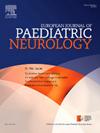Towards new perspectives: International consensus guidance on dystonia in pediatric palliative care
IF 2.3
3区 医学
Q3 CLINICAL NEUROLOGY
引用次数: 0
Abstract
Background
Pediatric dystonias are associated with a broad spectrum of etiologies, resulting in a heterogeneous patient population in whom clinical presentation, evolution, and therapeutic needs may differ. These neurological symptoms are particularly common in children and adolescents with life-limiting and life-threatening conditions requiring pediatric palliative care (PPC). The impact on the child's quality of life is significant, as is distress for caregivers. Addressing and alleviating dystonia is key to providing good palliative care; however, there is limited evidence. A greater recognition and management of dystonia in this setting is urgently needed to provide appropriate interventions and care.
Objectives
To develop a standardized approach to dystonia in PPC.
Materials and methods
A two-round Delphi process explored the views of experts on the definition, assessment, monitoring, and treatment of dystonia in PPC. Professionals from different backgrounds and disciplines were invited worldwide. The final panel comprised 71 participants who completed a multi-statement online questionnaire.
Results
Fifty-three items were endorsed, providing expert, consensus-based recommendations.
Conclusions
The limited clinical knowledge of childhood dystonia represents a challenge, especially in children with palliative care needs. This study is a first international consensus on dystonia in PPC and offers novel approaches to improving the dystonia-related burden and advancing clinical practice in this vulnerable population.
迈向新视角:儿童姑息治疗中肌张力障碍的国际共识指南
背景:小儿肌张力障碍与广泛的病因相关,导致患者群体异质性,其临床表现、发展和治疗需求可能不同。这些神经系统症状在需要儿科姑息治疗(PPC)的限制生命和危及生命疾病的儿童和青少年中尤其常见。这对儿童生活质量的影响是巨大的,对照顾者的痛苦也是如此。解决和缓解肌张力障碍是提供良好姑息治疗的关键;然而,证据有限。在这种情况下,迫切需要更好地认识和管理肌张力障碍,提供适当的干预和护理。目的建立治疗PPC肌张力障碍的标准化方法。材料与方法通过两轮德尔菲法探讨专家对PPC肌张力障碍的定义、评估、监测和治疗的看法。邀请了来自世界各地不同背景和学科的专业人士。最后的小组由71名参与者组成,他们完成了一份包含多个陈述的在线问卷。结果通过了53个项目,提供了基于专家共识的建议。结论有限的儿童肌张力障碍的临床知识是一个挑战,特别是在有姑息治疗需求的儿童中。这项研究是PPC中肌张力障碍的第一个国际共识,并为改善肌张力障碍相关负担和推进这一弱势人群的临床实践提供了新的方法。
本文章由计算机程序翻译,如有差异,请以英文原文为准。
求助全文
约1分钟内获得全文
求助全文
来源期刊
CiteScore
6.30
自引率
3.20%
发文量
115
审稿时长
81 days
期刊介绍:
The European Journal of Paediatric Neurology is the Official Journal of the European Paediatric Neurology Society, successor to the long-established European Federation of Child Neurology Societies.
Under the guidance of a prestigious International editorial board, this multi-disciplinary journal publishes exciting clinical and experimental research in this rapidly expanding field. High quality papers written by leading experts encompass all the major diseases including epilepsy, movement disorders, neuromuscular disorders, neurodegenerative disorders and intellectual disability.
Other exciting highlights include articles on brain imaging and neonatal neurology, and the publication of regularly updated tables relating to the main groups of disorders.

 求助内容:
求助内容: 应助结果提醒方式:
应助结果提醒方式:


